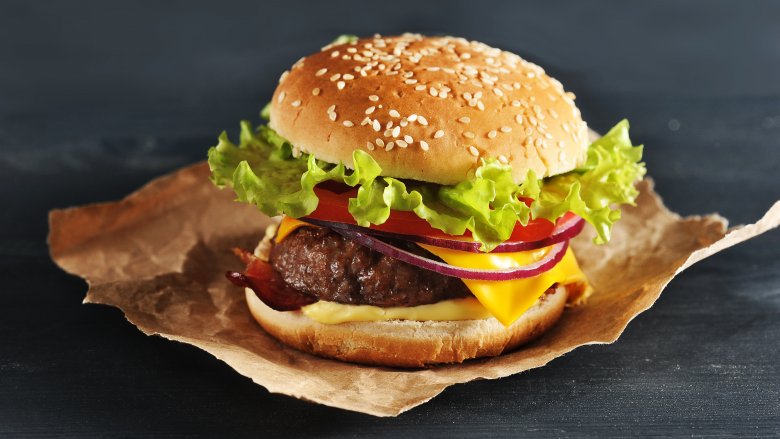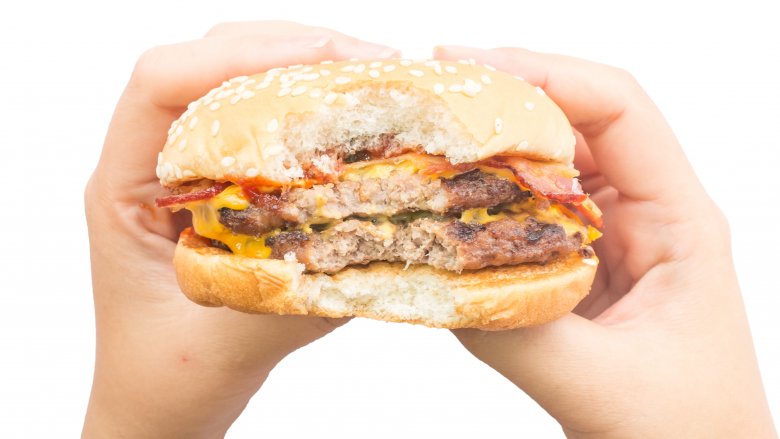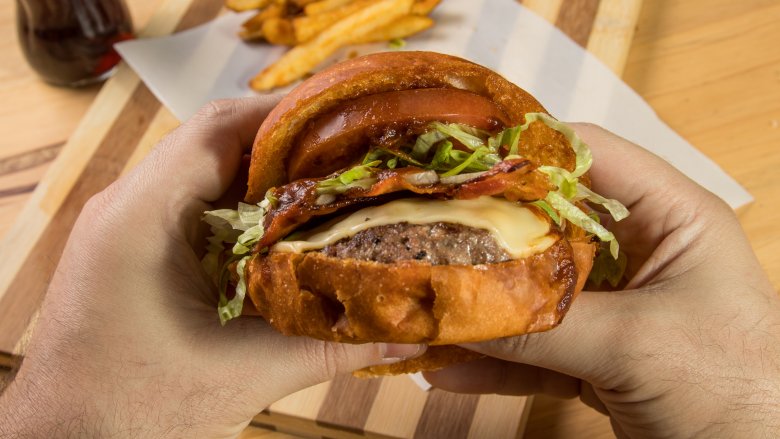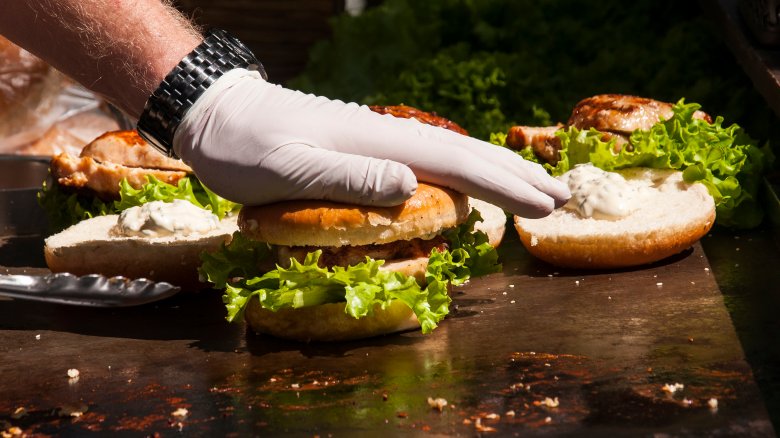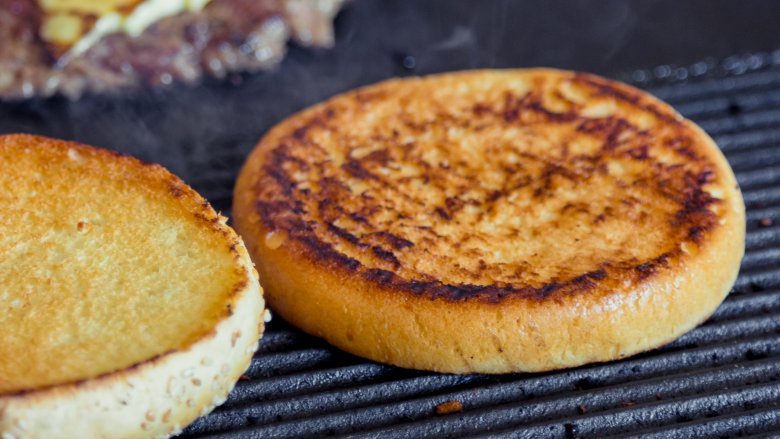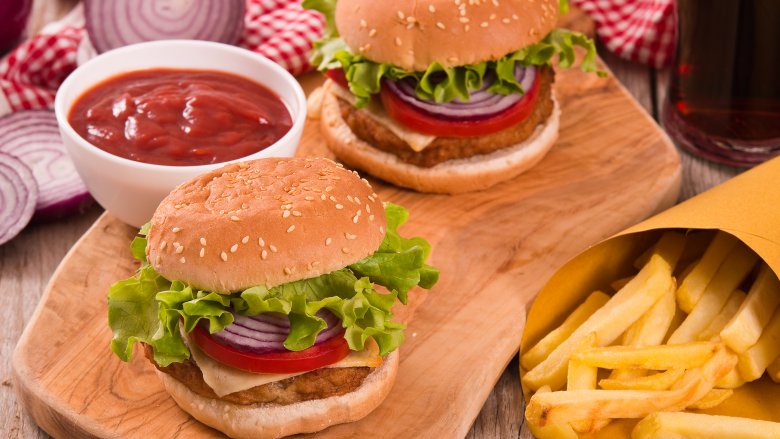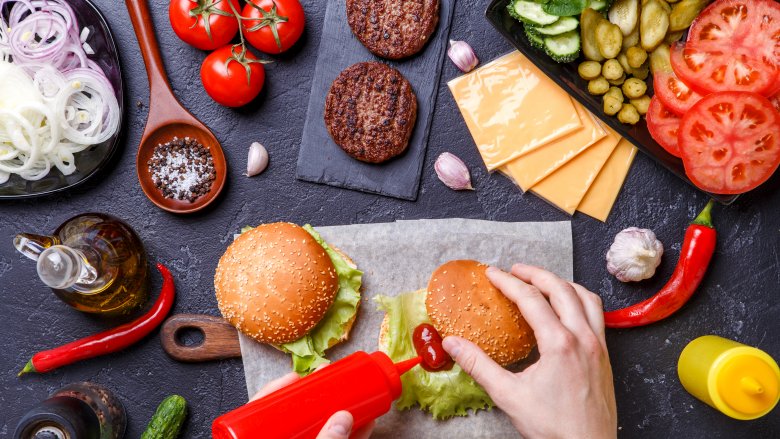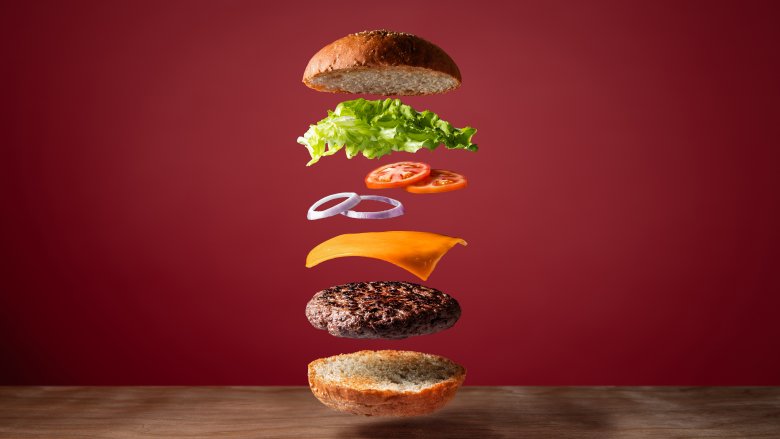You've Been Eating Your Burgers The Wrong Way
If there's one thing we can rely on the internet for, it's to be told what we're doing wrong. From how we're curling our hair wrong to all the ways we're jogging incorrectly, no topic is safe from criticism. But it's foods — the way we eat them and the way we prepare them — that cause some of the biggest online stir. Yes, according to the internet, we're eating just about everything incorrectly, whether it's cake, bananas, soup, or even burgers.
You didn't really think the way we eat burgers was exempt from the scorn of the internet, did you? No, it turns out that we're eating burgers all wrong, from the way we're holding it to the way we're assembling it, and even where we're putting the ketchup. The good news is that the "right" way to eat a burger isn't complicated, and hey, even if you eat it the "wrong" way, it's still going to taste great.
You're not holding it right
When it comes to all the ways we're eating our burgers wrong, this may be the biggest bombshell of all: You're not holding your burger correctly. Yes, you read that right — apparently after all these years of burger eating, we still don't know what we're doing.
That's according to Insider anyway, who spoke to experts who say that the proper way to eat a burger is to flip it upside-down. Simon Dukes, founder of the blog Burger Lad, explained, "The crown (the top of the bun) is generally thicker (and therefore stronger) than the heel, so for a better eating experience, you should actually flip it upside-down to eat it. The crown will then hold the weight of everything else, and there is less likelihood of it falling apart in your hands. A true burger connoisseur should always eat their burgers upside down."
Insider put the upside-down burger method to the test, and in the end they did agree that the thicker top bun absorbed the juices nicely, ensuring that the already-soggy bottom bun didn't disintegrate further. Who knew?
Your fingers are in the wrong spot
It turns out there's more than one wrong way to hold a burger, but this time you can keep your sandwich right side up and concentrate on where you're putting your fingers instead.
Kotaku reports that a group of Japanese researchers spent four months (yes, really) analyzing the best way to eat a large burger, focusing on the proper finger placement. They determined that the standard "eight fingers on top, thumbs on the bottom" technique just doesn't cut it, as this approach puts uneven pressure on the patty and the toppings, eventually forcing everything out the back of the bun. The solution? Thanks to 3D scans and much data, we now know that holding the burger with the thumbs and pinkies underneath, and remaining six fingers on top, gives us the best shot at keeping the entire sandwich intact with each bite. Is it the most comfortable position? No. But is it worth not losing the contents of your burger? That's for you to decide.
You're pressing down on it
Some burgers are impossibly tall, with their fluffy buns, thick half-pound patties, and slew of gourmet toppings. But if your first instinct is to press down on that meaty sky-scraper, you'll want to reconsider. That's according to Josh Capon, chef and co-owner of Burger & Barrel, and multi-time Burger Bash champion, who obviously knows a thing or two about hamburgers.
Capon cites this as a big burger-eating faux pas, and says you won't be doing the sandwich any favors by smashing it into submission. "Don't press it down. I didn't press the patty while I was cooking, so neither should you," he cautions. "Leave those lovely juices inside the patty where they belong." Aside from keeping the patty as plump as the chef intended, by not pressing down on the burger you're also ensuring that all those extra juices don't run out into the bun. The more juice that stays in the burger, the less soggy the bun. It's a win, win.
You're not toasting the bun
A good way to ruin an otherwise perfect burger is a soggy bun. You might think this is out of your control — that juicy patties automatically mean soggy, disintegrating bread — but it doesn't have to be that way. Just one simple step can help stave off the sog. You guessed it: If you're not toasting your hamburger buns, you're doing it wrong.
According to Ballpark, aside from the sogginess factor, there are two other good reasons to toast your buns: Texture and flavor. Not only does toasting strengthen the bread and prevent that top layer from immediately absorbing all the juice from the patty and condiments, but it also introduces a crispy texture to the overall burger, which is a nice balance to any softer toppings you may have included. And if you lightly butter those buns before tossing them on the grill — boosting the flavor considerably — well, you've hit the bun trifecta. Because let's face it... the texture and flavor of buttered toast is better than the texture and flavor of bread, whether you're eating it plain or as a sandwich — and burgers are no exception.
You're putting the condiments on wrong
Surprisingly, there's a lot that can go wrong when it comes to condiments, and you're probably guilty of subjecting your burger to at least one of these erroneous application methods.
Do you dip each bite in ketchup? You might think it tastes good — that is, if you really like ketchup — but dunking your burger in any condiment is a surefire way to mask all the other flavors. If you want a spoonful of ketchup, by all means, go for it, but if you want to taste the grilled, meaty flavors of your burger, spread the condiments evenly on the bun instead.
And on that subject, let's talk about the right way to spread those condiments. If you're going all out with the holy trinity of ketchup, mayo, and mustard, slather the top bun with the mayo, and the bottom bun with the ketchup and mustard. Distributing the condiments over both buns means that there's less accumulation to drip out, and it also ensures that the more delicate mayonnaise flavor hits before the rest of the bite, leaving the stronger, more overpowering flavors of the ketchup and mustard for last.
You're putting the cheese in the wrong spot
Where you put your cheese depends on your ultimate burger goals. You can place it between the patty and the bottom bun if you're worried about sogginess, or you can place it directly on top of the patty if you're worried about topping slippage. Other placement options would fall into the "wrong" category.
Dan Pashman, host of the food podcast, The Sporkful, told The Takeout that if you don't want to be that person who eats their burger upside-down, but do want to avoid the disintegrating bun situation, simply place the cheese under the patty. He says this will help to "create a seal so you don't have quite so much juice flowing directly onto the bottom bun."
If a soggy bottom bun isn't your concern, placing the cheese in the standard spot atop the patty will help keep the next topping in place. Do this while the patty is still hot enough to melt the cheese, and the glue-like effect will be even more effective. There's just one caveat to this rule, according to The Kitchn: If you're adding bacon, place it between the patty and the cheese. Not only does it keep those strips in place, it also gives you that delicious meat-on-meat flavor.
You're putting the toppings on wrong
Even with the cheese and the condiments sorted out, you've still got to worry about layering all the other toppings correctly. One wrong move and things can take a turn for the worse in a hurry. So what's the right way?
Bottom bun, ketchup and mustard, pickles, patty, cheese (if that's the way you roll, otherwise put it underneath the patty and keep your burger right side up), tomato, lettuce, onion, mayo, top bun. It might not seem like it makes a difference, but the order is particularly important when it comes to the tomato and the lettuce. See, the slippery tomato slices adhere to the melty cheese, ensuring they don't shoot out the back of your burger on the first bite. And if you were to put the lettuce any closer to the hot patty, it would wilt in a hurry. Soggy, limp lettuce is never a desired burger topping.
Bottom line: When each component of your burger is at its best, you'll know at first bite that you're eating it the "right' way.
